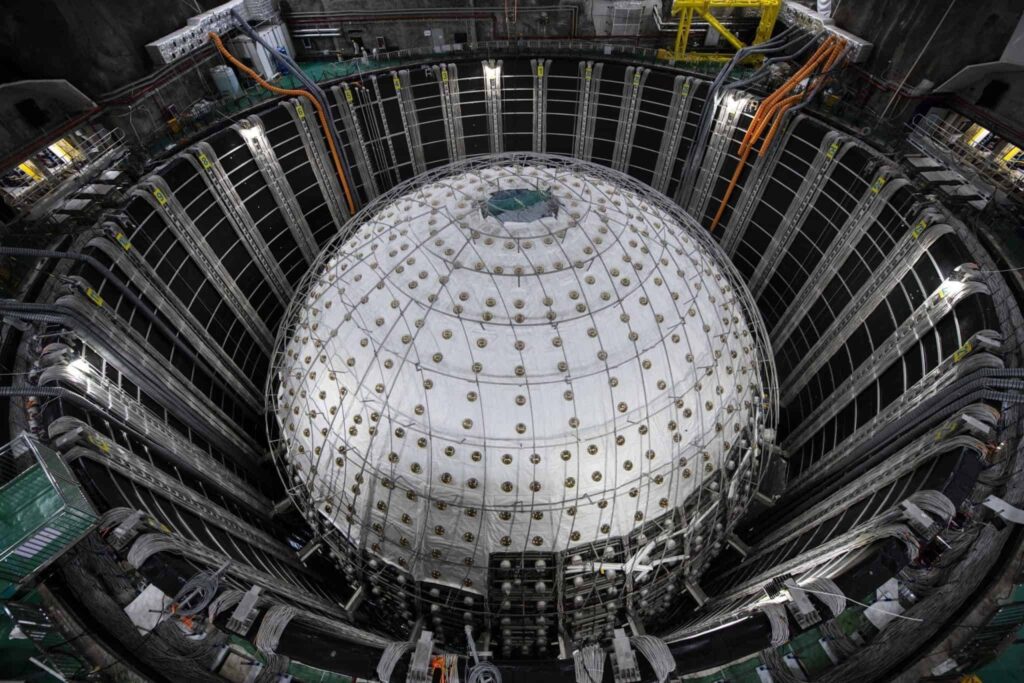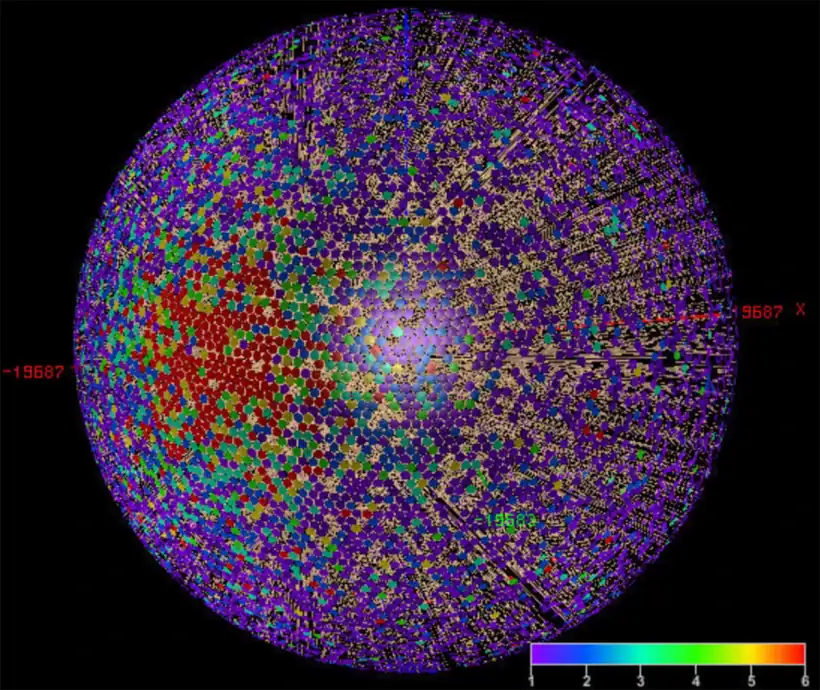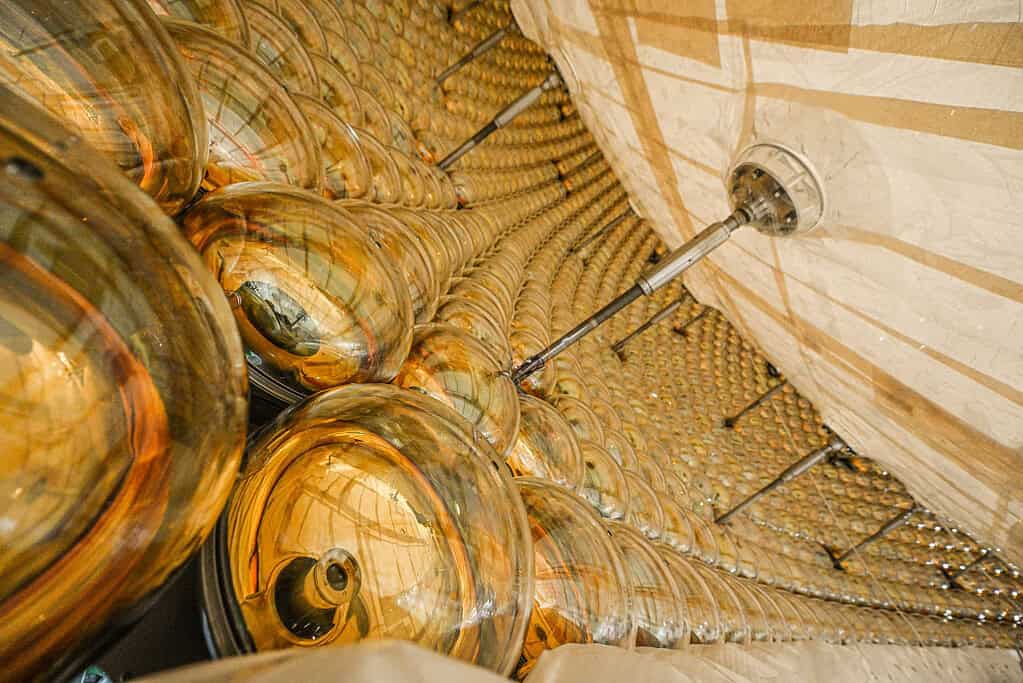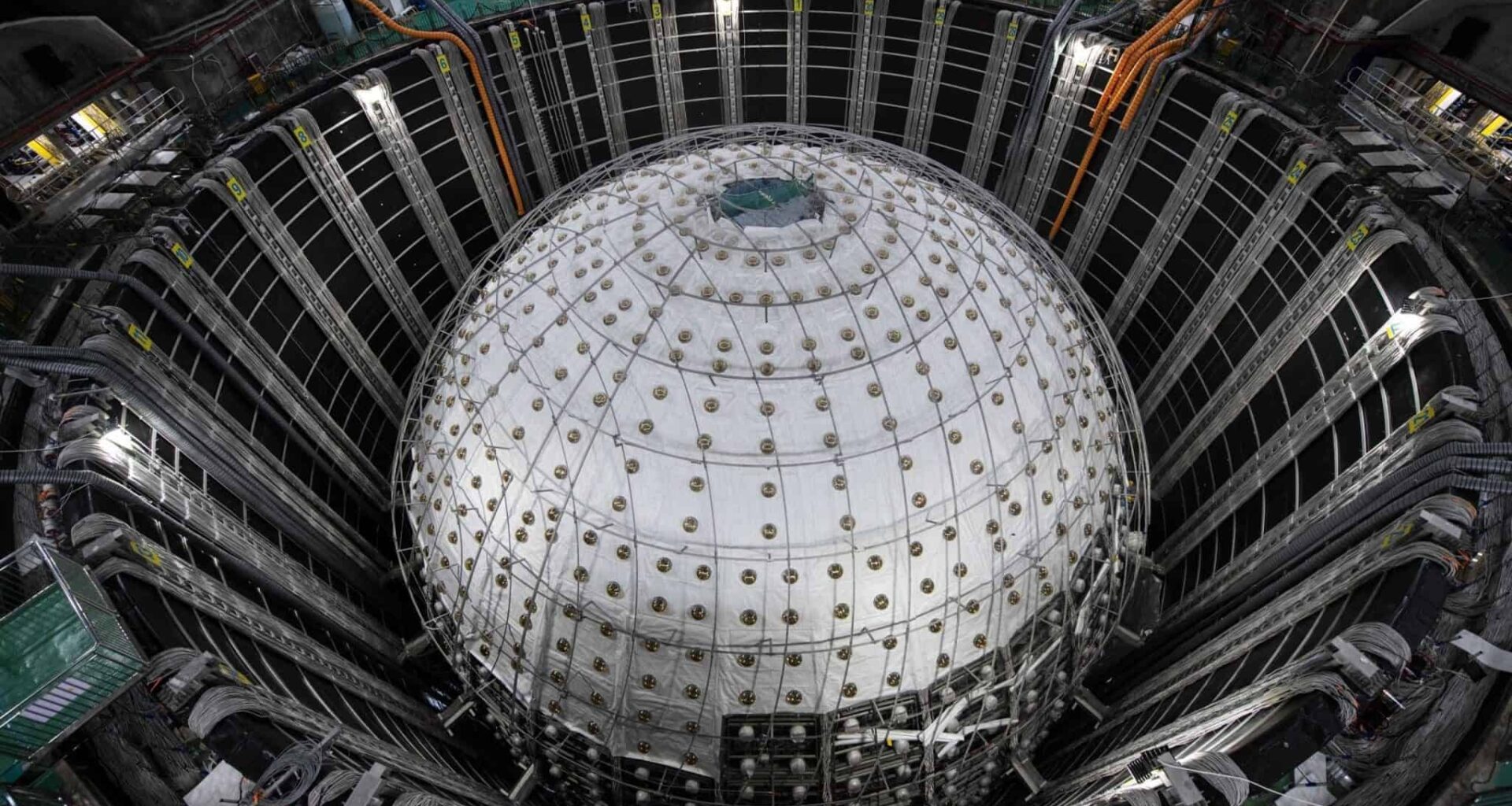 This stitched photo taken on Oct. 9, 2024 shows the central detector of the Jiangmen Underground Neutrino Observatory (JUNO) in Jiangmen, south China’s Guangdong Province. The spherical central detector with its 43,000 photosensors is in a water pool with a diameter of around 44 meters that will later serve as an active shield against cosmic radiation and natural radioactivity. Credit: Xinhua/Jin Liwang.
This stitched photo taken on Oct. 9, 2024 shows the central detector of the Jiangmen Underground Neutrino Observatory (JUNO) in Jiangmen, south China’s Guangdong Province. The spherical central detector with its 43,000 photosensors is in a water pool with a diameter of around 44 meters that will later serve as an active shield against cosmic radiation and natural radioactivity. Credit: Xinhua/Jin Liwang.
Neutrinos slip through your body by the trillions each second. They rarely hit anything. They barely seem to exist. Yet a sprawling underground experiment in southern China has just shown that these “ghost particles” may be breaking the rules we thought they followed.
The Jiangmen Underground Neutrino Observatory (JUNO) — now the world’s largest neutrino detector — has confirmed a subtle mismatch in neutrino behavior. Physicists have debated about it for years. Now it is real.
And that early result came from only 59 days of data.
The ‘Ghost’ detector
JUNO sits 700 meters beneath a mountain near Guangdong. Engineers carved a sloped tunnel down into the rock and built a liquid-filled sphere the size of a small office building. Inside, 20,000 tons of ultraclear scintillator wait for passing neutrinos. When one interacts with a proton, a tiny flash of light appears. More than 43,000 photomultiplier tubes record the spark.
The scale is staggering: JUNO’s detector is 20 times larger than the Japanese KamLAND experiment, which is of comparable scope and design, and its light-collection technology is more sensitive than anything used before. “There’s not a lot of room for mistakes,” said J. Pedro Ochoa-Ricoux, a physicist at UC Irvine who works on JUNO. But so far, JUNO hasn’t made any.
The $350-million facility became fully operational in late August to much fanfare. By November, it had already delivered its first surprise.
 A neutrino detected by JUNO on 24 August, as recorded by the experiment’s approximately 43,000 photomultiplier tubes. Credit: JUNO Collaboration.
A neutrino detected by JUNO on 24 August, as recorded by the experiment’s approximately 43,000 photomultiplier tubes. Credit: JUNO Collaboration.
Early measurements revealed that solar neutrinos behave a little differently than neutrinos from nuclear reactors. That tension — first hinted at by earlier experiments — now stands confirmed. JUNO measured two key “solar neutrino oscillation” parameters, θ₁₂ and Δm²₂₁, with a 1.6 times better precision than all previous experiments combined.
“Achieving such precision within only two months of operation shows that JUNO is performing exactly as designed,” said project manager Wang Yifang.
Scientists once wondered whether the discrepancy was an artifact of noisy data. JUNO has now shown it’s not.
This signals something deeper. Maybe it’s new physics or just a gap in our models. Or even more groundbreaking yet, maybe it’s the first real crack in one of science’s most stubborn frontiers.
A Tension with History
 On the left half, you can see the photosensors that form JUNO’s inner active shield. On the right, there is the acrylic sphere, which is currently being filled with scintillation fluid. Credit: JUNO Collaboration.
On the left half, you can see the photosensors that form JUNO’s inner active shield. On the right, there is the acrylic sphere, which is currently being filled with scintillation fluid. Credit: JUNO Collaboration.
The Standard Model of particle physics has always treated neutrinos as massless. Then experiments in Japan and the United States revealed that neutrinos can oscillate between three “flavors” — electron, muon, and tau — as they travel through space. This quantum shapeshifting implies that neutrinos have mass, but no one knows how much, or which type is heaviest.
That’s where JUNO comes in. Its main mission is to determine the neutrino mass ordering — whether the three masses follow a normal pattern (lightest to heaviest) or an inverted one. The answer could help explain why matter survived the Big Bang instead of being annihilated by antimatter.
“Mass ordering is the gateway for the ultimate question,” Sam Zeller, deputy project director for the U.S. DUNE detector, told Physics Today. “We’d all like to know why we’re here, why we exist, and we’re hoping that neutrinos hold that clue.”
JUNO measures the delicate oscillation patterns of reactor antineutrinos from two nearby nuclear power plants. Each event helps physicists narrow down the parameters that describe how neutrinos morph from one form to another. After about six years of continuous data, the team expects to determine the mass hierarchy with a three-sigma confidence level.
This friendly race among continents is reshaping neutrino science. “JUNO’s success reflects the commitment and creativity of our entire international community,” said Marcos Dracos of the University of Strasbourg and CNRS/IN2P3 in France. More than 700 scientists from 74 institutions in 17 countries are part of the collaboration.
Because reactor neutrinos have low energy, JUNO needs exquisite calibration. To measure the oscillation parameters θ12 and Δm²21, the experiment must hit 3% energy resolution at 1 MeV with less than 1% uncertainty.
Yet JUNO met and surpassed its own specs almost immediately.
Other major experiments will also chase mass ordering. America’s Deep Underground Neutrino Experiment (DUNE) expects to reach a definitive five-sigma measurement once running. Japan’s Hyper-Kamiokande will mix atmospheric and accelerator neutrinos.
What Comes Next
Once JUNO nails down the mass ordering, it will open new doors in physics, astrophysics, and even Earth science.
The detector is so sensitive it could catch the first faint neutrino signals from a nearby supernova, giving astronomers an early warning that a star is about to explode. It will also study geoneutrinos — antineutrinos streaming from radioactive decay inside Earth’s crust and mantle — to reveal how much heat our planet generates from within.
“JUNO will continue to deliver important results and train new generations of physicists for decades to come,” said Cao Jun, director of the Institute of High Energy Physics.
Each of these goals pushes at the same boundary: what neutrinos can tell us about the origins of matter, energy, and everything we can see.
